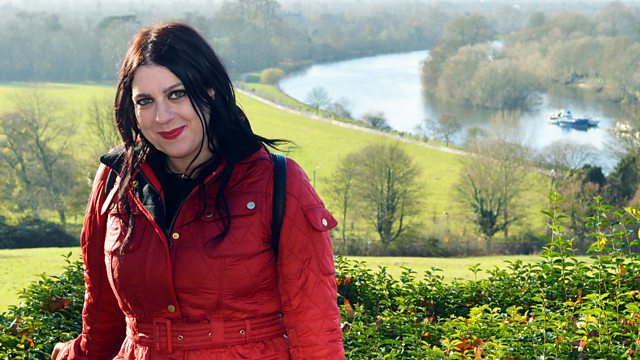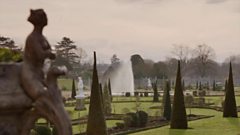
In Search of Arcadia
Janina Ramirez and waterman John Bailey explore the 18th-century origins of the English landscape movement in a 12-mile stretch of the Thames between Hampton and Chiswick.
Dr Janina Ramirez goes 'In Search of Arcadia' discovering the origins of the English landscape movement in a 12-mile stretch of the Thames between Hampton and Chiswick with waterman and historian John Bailey.
In the early 18th century this stretch of the river was home to a group of writers, poets, artists and garden designers who were inspired by classical landscapes of antiquity and the ancient idea of Arcadia.
Janina discovers the people and the ideas at the heart of this transformative movement and the landscape of the Thames - Nicholas Poussin's painting Et in Arcadia Ego, the French formal gardens at Hampton Court, Pope's Grotto, Marble Hill House, Chiswick House, Syon Meadows and finally the view from Richmond Hill.
John unpacks the role the River Thames played in their story as he explores the natural riches of its shores. He has time for fishing and contemplation along the way with his guide - Izaak Walton's Compleat Angler.
Janina starts with the most famous of Arcadian paintings, Et in Arcadia Ego by Nicholas Poussin, at Garrick's Temple in Hampton. She explains the ancient concept of Arcadia - a lost paradise where man and nature lived in perfect harmony. It's an idea that emerges in many cultures, but in Britain in the 17th and 18th century this ancient philosophy inspired a revolution in painting, writing, architecture and garden design.
Janina and John set off down the Thames on a traditional Thames wherry. John gives Janina his copy of Izaak Walton's fishing manual The Compleat Angler. Published in 1653 it's a book that has been reprinted over 400 times. John and Janina discover the book is much more than a practical fishing manual. It is also a philosophic treatise in which Izaak Walton first proposed an Arcadian philosophy; a vision of a world where man and nature lived in perfect harmony. He suggested that through the studied contemplation of the landscape, mankind could achieve a higher moral wisdom and virtuous understanding of the universe.
Janina and John arrive at Hampton Court Palace. John experiences Walton's philosophy first-hand, angling with fellow Walton enthusiast Keith Elliott. Janina explores the magnificent but formal Privy Gardens, commissioned by William III in 1702. Janina contemplates how at odds this formal garden is with the idea of a pastoral Arcadia. The formal French garden is beautiful and perfect, but nature is enslaved in it. This is very different to Izaak Walton's idea of Arcadia where man and nature co-exist in a perfect pastoral idyll. Two of Britain's greatest writers and poets, Joseph Addison and Alexander Pope, started a quiet rebellion against this subjugation of nature by publishing satirical articles in the Spectator and the Guardian.
Janina meets Dr Ross Wilson, a professor of English literature, in one of the oldest pubs in Twickenham. He explains why Pope - a writer - is often considered the true architect of the Arcadian movement. Pope built a house and a garden in Twickenham. They were demolished years ago, but one feature of the original estate still remains - Pope's Grotto. This man-made cavern became a retreat for Pope and is often considered the first museum of geology in Britain.
Next is Marble Hill House, home of King George II's mistress Henrietta Howard, a great friend and patron of Pope and the arts. Dr Esme Whittaker explains that Henrietta's patronage helped to accelerate the spread of this emerging cultural movement which sought to recreate classical scenes in the landscape.
Meanwhile, John is at Ham Lands with a group of volunteers restoring an original avenue using 'Arcadian' methods.
Palladian architecture also perfectly matched the emerging taste for naturalised gardens. These ideas were taken to the next level by wealthy and influential patrons including Lord Burlington. At Chiswick, Janina visits his Palladian villa set in one of the last remaining early examples of an English landscape garden. Joined by John Watkins, a specialist in the English landscape movement, she finds out how the ideas first expressed in Pope's garden were translated by others to create the naturalised garden at Chiswick.
Lord Burlington designed these gardens with royal gardener Charles Bridgeman and William Kent, whose famous protege was Capability Brown. And to see how Brown took these ideas to the next level, John heads out on the river with landscape historian Jason Debney to see one of the last remaining 18th-century Arcadian landscapes at Syon Meadows.
Finally Janina and John meet Sir David Attenborough and Kim Wilkie, patron and founder of the Thames Landscape Strategy on Richmond Hill overlooking the only view in Britain protected by act of Parliament. This view inspired JMW Turner to paint his famous landscape Richmond Hill in 1820, and it has barely changed since then. So if you had to sum up Arcadia in a word, a poem, a painting or a view - perhaps this is it.
Last on
Clip
-
![]()
The majestic gardens at Hampton Court Palace
Duration: 02:07
Credits
| Role | Contributor |
|---|---|
| Presenter | Janina Ramirez |
| Presenter | John Bailey |
| Production Company | Tin Can Island Ltd |
| On-line editing | Nikki Chang |
| Editor | Johnny Moore |
| Executive Producer | Emma Cahusac |
| Executive Producer | Andrea Cornes |
| Producer | Fiona Ryder |
| Director | Fiona Ryder |
Broadcasts
- Wed 9 Aug 2017 21:00
- Thu 10 Aug 2017 02:20
- Mon 8 Jul 2019 22:00
Featured in...
![]()
Painters and their Masterpieces
Documentaries exploring the lives and works of great painters and artists.
![]()
Art on 麻豆官网首页入口 Four
The stories behind iconic works of art.


